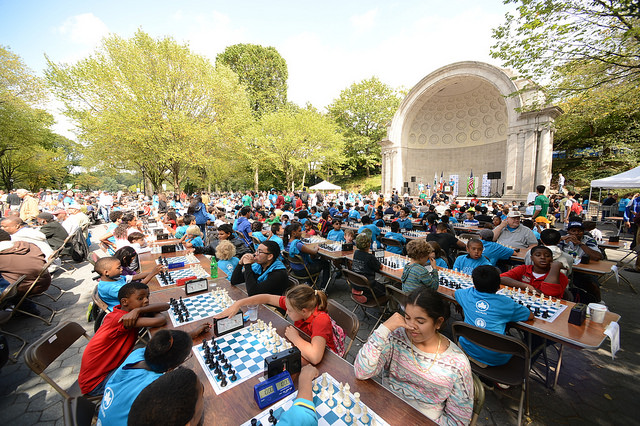
(photo: Parks Department)
New Yorkers are all too familiar with the consequences of aging urban infrastructure. Years of underinvestment in New York City’s century-old subway system has led to a full-blown transit crisis, with rampant delays, consistently overcrowded trains, and frequent equipment breakdowns.
But the subways are just the most glaring problem in an aging city. Another vital piece of public infrastructure is also several decades old, years behind on basic maintenance, and nearing a breaking point: New York City’s parks system.
With more than 100 million parks visitors each year and the city’s population at a record high, New York’s 1,700 public parks have never been busier. These open spaces provide a communal backyard to millions, with major benefits for health and happiness in every corner of the city. But the combination of advanced age, record usage, and decades of underinvestment in maintenance and infrastructure means that serious cracks are showing.
The average city park is 73 years old, and parks in every borough are struggling with aging assets that are at or near the end of their useful lives—including drainage systems, retaining walls, and bridges. About 40 percent of pools and almost half of the 53 recreation centers in city parks were built before 1950. The waterfront facilities overseen by the Parks Department—148 miles of coastline, including beaches, marinas, piers, and docks—are on average 76 years old.
Yet one in five parks has not had a major infrastructure upgrade in 25 years, according to a new report from the Center for an Urban Future. At least 46 parks, triangles, and plazas have not received significant capital investment in nearly a century.
In many cases, the results are plain to see. Serious flooding, damaged pathways, missing stairs, out-of-order bathrooms, and neglected horticulture are common problems in parks across all five boroughs. Other times, the infrastructure issues are hidden from view. For example, numerous drainage systems in city parks still rely on clay pipes from the mid-20th century. Most of the city’s thousands of park retaining walls are cracking and in need of repair or replacement. And one in five park bridges was found to be seriously deteriorated during its most recent inspection.
As maintenance and infrastructure needs soar, the city has struggled to keep pace. The Parks Department’s state-of-good-repair needs jumped 45 percent over the past decade, from $405.9 million in 2007 to $589.1 million last year. Meanwhile, recommended maintenance needs more than doubled, from $14 million to $34 million. But fewer than 15 percent of these needs were funded in the city’s most recent budget—among the lowest levels of any agency.
Although age is the major culprit contributing to mounting infrastructure needs, decades of underinvestment in basic maintenance has taken a toll. The Parks Department has too few full-time staff—including plumbers, masons, and gardeners—to keep parks assets in good shape and mitigate problems before they grow. New York’s system has about 150 gardeners citywide for roughly 20,000 acres of parkland—a ratio of 1 gardener to every 133 acres. By comparison, San Francisco employs over 200 gardeners for 4,113 acres of parkland—a ratio of 1 to 20.
Mayor Bill de Blasio and the City Council deserve credit for taking important steps to address parks infrastructure needs. In recent years, the Community Parks Initiative and Anchor Parks Initiative have dedicated more than $300 million to improve chronically underfunded parks, with significant benefits in every borough. But there’s still much more work to do to shore up the city’s aging parks system and lay the foundation for the next century of public open space.
It starts with committing to strategic increases in the Parks Department’s expense budget, with the goal of permanently funding much-needed skilled maintenance staff such as gardeners and foresters, masons, plumbers, electricians, mechanics, and other skilled workers, while closing the maintenance gap. In addition, the mayor and the City Council should establish a dedicated pool of capital funds for the parks system’s unsexy infrastructure—such as drainage systems and retaining walls—which are often passed over in discretionary funding.
To pay for all this, New York City should explore new revenue streams dedicated to parks maintenance and unglamorous capital projects. For example, a small surcharge on tickets to sporting events and greens fees at city golf courses could fund routine maintenance at parks, playgrounds, and recreation centers. Likewise, a surcharge on dockage fees at city-owned marinas could be used to maintain waterfront facilities. There are also numerous parks where the city could add a reasonable number of concessions that enhance the experience of parkgoers while providing vital new sources of revenue.
Given the scale of the parks system’s needs, the city’s capital dollars need to stretch as far as possible. But today, that’s hardly the case. A single bathroom can cost upward of $3 million and ten-year renovations are not uncommon. The mayor should make reforming the broken capital construction process a top priority, and the Parks Department should work to significantly speed up each phase of the process under its control.
New York’s public parks have benefited countless New Yorkers for well over a century. By investing wisely in their revitalization, these essential open spaces can continue to thrive into the next century and beyond.
***
Eli Dvorkin is managing editor of the Center for an Urban Future, a New York–based think tank focused on expanding economic opportunity. On Twitter @nycfuture & @wetwax.
***
Have an op-ed idea or submission for Gotham Gazette? Email This email address is being protected from spambots. You need JavaScript enabled to view it.




